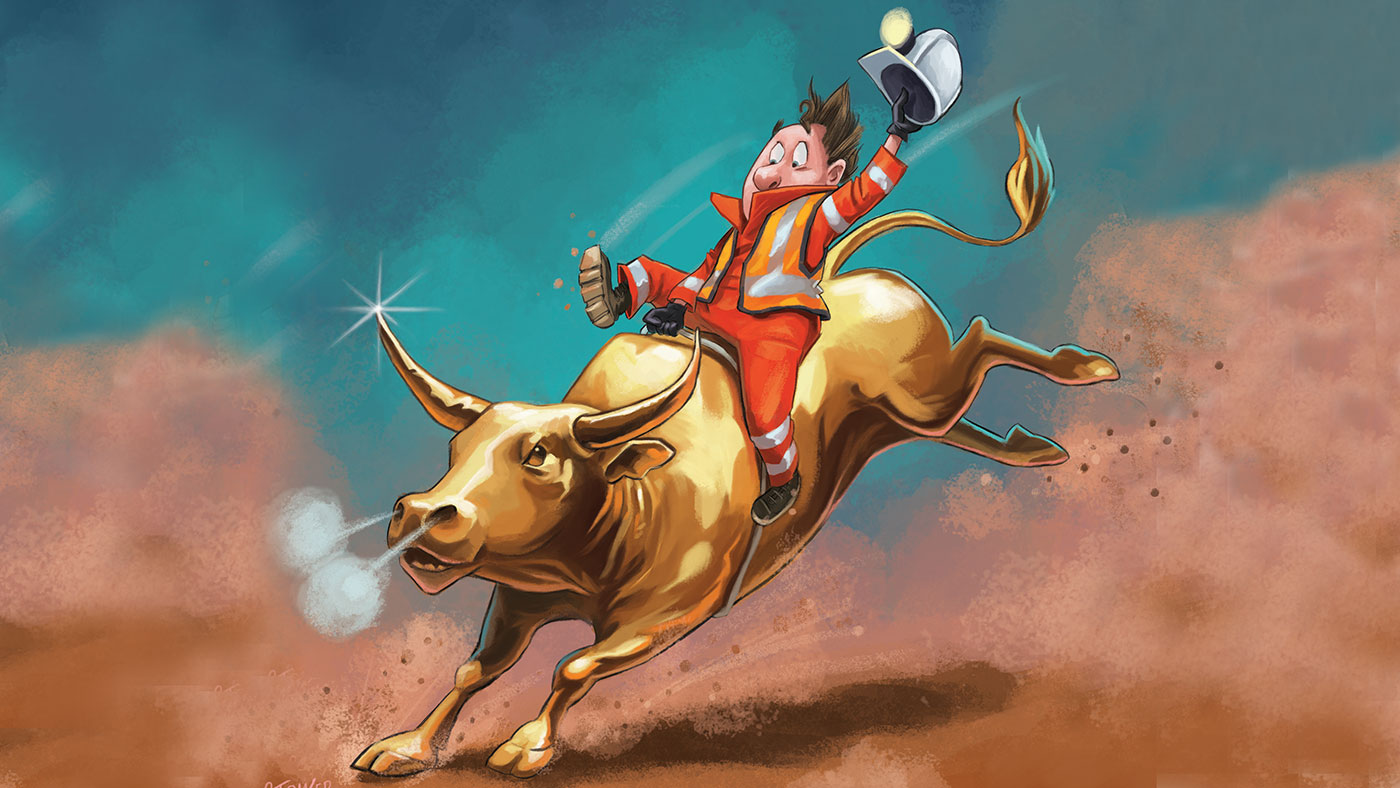Sit tight and ride the gold bull: the upswing is just beginning
With money being printed like there’s no tomorrow, the backdrop for the yellow metal and miners remains auspicious, says Dominic Frisby. Here, he reviews his recent tips and suggests some more.


One of the best books on investment you will ever read is Edwin Lefevre’s Reminiscences Of A Stock Operator. It’s a thinly disguised biography of Wall Street legend Jesse Livermore, regarded by many as the greatest trader who ever lived. I am not alone in having a great affection for the passage in which Larry Livingston (a pseudonym for Livermore) recalls a veteran trader, old Mr Partridge, with whom the firm was extremely unhappy because he was giving “very little in the way of commissions”.
Every time old Mr Partridge was given a tip to sell a stock so that he could buy it back at lower prices, he would thank the tipster politely, smile and just say, “It’s a bull market”. He didn’t want to lose his position. Livermore concludes: “In a bull market your game is to buy and hold until you believe that the bull market is near its end”. “Money is made by sitting, not trading,” Livermore said. “It never was my thinking that made the big money for me. It always was my sitting. Got that? My sitting tight!”
The other side of the trade
Should we keep sitting tight? Monday and Tuesday’s violent correction saw gold give back over $200, having hit a record peak above $2,070 last week. Silver lost a fifth of its value. However, to me this feels like a sell-off of the “healthy correction in a bull market” variety. One reason to think so lies in the other side of the gold trade: the US dollar. Gold is priced in dollars and so they have an inverse relationship; a fall in the dollar makes gold cheaper in other currencies. The greenback has been sinking since mid-March, when the US dollar index (a measure of the dollar against the currencies of its main trading partners) was at 103. Now it’s at 93.
MoneyWeek
Subscribe to MoneyWeek today and get your first six magazine issues absolutely FREE

Sign up to Money Morning
Don't miss the latest investment and personal finances news, market analysis, plus money-saving tips with our free twice-daily newsletter
Don't miss the latest investment and personal finances news, market analysis, plus money-saving tips with our free twice-daily newsletter
President Donald Trump wants a weaker dollar. He has said so many times. In an election year it matters even more. When the dollar is weak, assets tend to rise and so people feel richer. He wants people feeling rich. They will be more likely to vote for him. If the dollar goes to 88 – and bear in mind that it spent the entire period from 2006 to 2014 below 88 – then gold will be a good two or three hundred dollars above where it is now. On the other hand, precious metals’ collapse this week was precipitated by a stabilisation in the dollar.
The dollar has further to fall
From a technical (chartist) point of view I’d like to see gold come back to around $1,800 or just below, kiss that level and then set off to the races. If the US dollar rally continues then that looks likely. But downward momentum in the dollar is so great that at the moment I have to say I will almost be more surprised if we don’t hit 88 this year than if we do.
The euro in particular looks like it’s begun a new bull market against the dollar. Gold’s strength is not just a weak US dollar story. It is a weak fiat currency story. It is a global money-printing bonanza story. Take sterling. In the first half of 2019, gold was trading below £1,000 an ounce. It began 2020 at £1,150/oz. Now it’s north of £1,500/oz.
A global money-printing bonanza
Circumstances are different from 2011, the last time gold was this high. In 2011, the concept of negative interest-rate policies barely existed. The US national debt was almost half what it is now. The Federal Reserve’s balance sheet was sub-$3trn, compared with $7trn today. The European Central Bank’s balance sheet has tripled since 2011. The Bank of England’s balance sheet has – well, expletives are not acceptable in this magazine.
The US dollar index, meanwhile, was at 73, a full 20 points lower than where it is today. It was, as much as anything, the dollar turning up after 2011 that did for gold and especially, for gold miners. In 2011 the bull market was ten years old. The narratives were tired. This bull market is not mature – it is, what, three, four years old? When did it start? December 2015 at $1,050? Or August 2018 at $1,170? If you say the latter, then we are not even two years in. There are a lot of people out there who are new to the gold story – and it is a persuasive one. I haven’t even been asked to go on the telly yet to talk about gold. It all says this bull market is young and points to higher prices down the road. How much higher?
To read the whole of this article, subscribe to MoneyWeek magazine
Subscribers can see the whole article in the digital edition available here
Get the latest financial news, insights and expert analysis from our award-winning MoneyWeek team, to help you understand what really matters when it comes to your finances.
Dominic Frisby (“mercurially witty” – the Spectator) is as far as we know the world’s only financial writer and comedian. He is the author of the popular newsletter the Flying Frisby and is MoneyWeek’s main commentator on gold, commodities, currencies and cryptocurrencies. He has also taken several of his shows to the Edinburgh Festival Fringe.
His books are Daylight Robbery - How Tax Changed our Past and Will Shape our Future; Bitcoin: the Future of Money? and Life After the State - Why We Don't Need Government.
Dominic was educated at St Paul's School, Manchester University and the Webber-Douglas Academy Of Dramatic Art.
You can follow him on X @dominicfrisby
-
 Football fans issued warning over ticket scams ahead of 2026 World Cup
Football fans issued warning over ticket scams ahead of 2026 World CupSantander customers lost more to football scams in the first six months of 2025 compared to the same period in 2024, when total losses surged due to the Euros
-
 Nationwide fined £44 million over “inadequate” anti-money laundering systems
Nationwide fined £44 million over “inadequate” anti-money laundering systemsFailings in Nationwide’s financial crime processes between October 2016 to July 2021 meant one criminal was able to deposit £26 million from fraudulent Covid furlough payments in just eight days.
-
 Who is Christopher Harborne, crypto billionaire and Reform UK’s new mega-donor?
Who is Christopher Harborne, crypto billionaire and Reform UK’s new mega-donor?Christopher Harborne came into the spotlight when it emerged he had given £9 million to Nigel Farage's Reform UK. How did he make his millions?
-
 The best Christmas gifts for your loved ones
The best Christmas gifts for your loved onesWe round up the best Christmas gifts with a touch of luxury to delight, surprise and amaze family and friends this festive season
-
 Leading European companies offer long-term growth prospects
Leading European companies offer long-term growth prospectsOpinion Alexander Darwall, lead portfolio manager, European Opportunities Trust, picks three European companies where he'd put his money
-
 How to harness the power of dividends
How to harness the power of dividendsDividends went out of style in the pandemic. It’s great to see them back, says Rupert Hargreaves
-
 Why Trustpilot is a stock to watch for exposure to the e-commerce market
Why Trustpilot is a stock to watch for exposure to the e-commerce marketTrustpilot has built a defensible position in one of the most critical areas of the internet: the infrastructure of trust, says Jamie Ward
-
 Tetragon Financial: An exotic investment trust producing stellar returns
Tetragon Financial: An exotic investment trust producing stellar returnsTetragon Financial has performed very well, but it won't appeal to most investors – there are clear reasons for the huge discount, says Rupert Hargreaves
-
 How to capitalise on the pessimism around Britain's stock market
How to capitalise on the pessimism around Britain's stock marketOpinion There was little in the Budget to prop up Britain's stock market, but opportunities are hiding in plain sight. Investors should take advantage while they can
-
 London claims victory in the Brexit wars
London claims victory in the Brexit warsOpinion JPMorgan Chase's decision to build a new headquarters in London is a huge vote of confidence and a sign that the City will remain Europe's key financial hub
